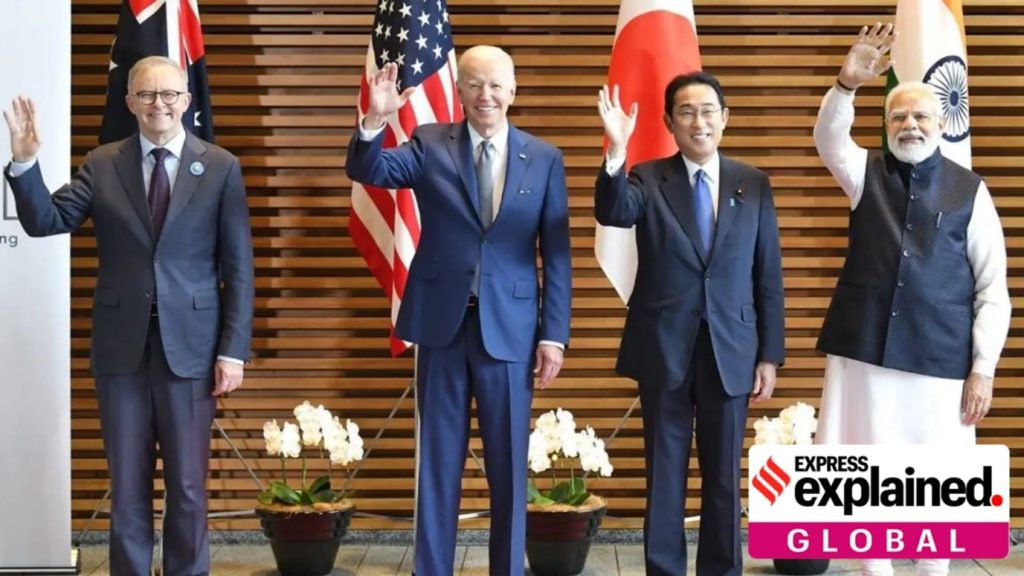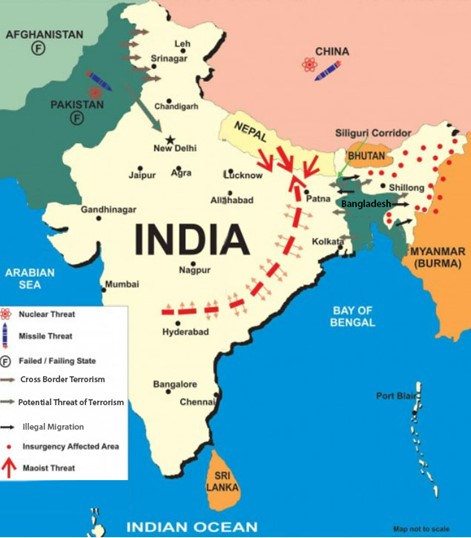Contents:
- Quad’s Light Touch
- In Our Defenece
- India Needs a ‘National Security Strategy’ for Comprehensive Defence
Quad’s Light Touch
Context: The Quad (Quadrilateral Security Dialogue) comprising India, the US, Japan, and Australia recently held its latest summit, where leaders discussed a variety of issues, from cybersecurity cooperation to port development in the Indo-Pacific region. Despite its increasing activity, the Quad has managed to avoid being labelled as an “Asian NATO,” focusing on public goods rather than overt military alliances. The summit reinforced the Quad’s role as a key player in regional cooperation without directly targeting any nation, particularly China.
Relevance: General Studies Paper II (International Relations)
Mains Question: Discuss the significance of the Quad in the context of Indo-Pacific security and regional cooperation. How has the Quad avoided being branded as an “Asian NATO”?

- Quad’s Strategic Role in the Indo-Pacific:
- The Quad is a platform for strategic dialogue between India, Japan, Australia, and the United States aimed at ensuring a free, open, and inclusive Indo-Pacific. The grouping focuses on fostering regional cooperation on non-military issues, such as climate change, cybersecurity, maritime infrastructure, and technology.
- The recent summit, hosted in Wilmington, Delaware, saw agreements ranging from the creation of an Indo-Pacific logistics network to advancements in biotechnology and quantum computing. These initiatives emphasize the Quad’s role in providing public goods rather than engaging in military alliances.
- Avoiding the “Asian NATO” Label:
- Despite the Quad’s growing influence, it has taken care to avoid being perceived as a military alliance akin to NATO. This strategy is crucial in maintaining the ASEAN region’s trust, as many ASEAN countries have historically been wary of any US-led security alliances directed against China.
- By focusing on non-military initiatives, the Quad has cultivated a cooperative relationship with ASEAN, positioning itself as a non-threatening entity that is concerned with regional development and cooperation rather than militarization.
- Challenges and China’s Influence:
- Although the Quad insists that it is not directed at China, its growing emphasis on Indo-Pacific security has undoubtedly been influenced by China’s assertive behavior in the region, particularly in the South China Sea. The US, through its parallel initiatives such as AUKUS (Australia-UK-US alliance), continues to maintain military deterrence in the region.
- For India, which remains the only “non-ally” of the US in the Quad, balancing its non-alignment policy while participating in the Quad’s security-focused discussions is delicate. India’s involvement is seen as part of its broader efforts to secure its maritime interests in the Indo-Pacific without overtly provoking China.
- Diplomatic Openings and Global Cooperation:
- As the Quad expands its agenda beyond the Indo-Pacific, its leaders also emphasized the importance of engaging diplomatically with China. At the Wilmington summit, President Biden signaled his intention to meet Chinese President Xi Jinping to ensure that diplomatic channels remain open despite growing tensions in the region.
- The Quad’s engagements continue to expand through other global platforms like G20, BRICS, and the East Asia Summit, ensuring that its cooperative agenda is seen as inclusive rather than exclusive to military concerns.

Additional Data:
- Quad Summit: Held six times in the past four years, signaling increased cooperation.
- Indo-Pacific Initiatives: Covering areas from cybersecurity to quantum computing.
Conclusion:
The Quad has carefully balanced its light-touch diplomacy with strategic goals in the Indo-Pacific, avoiding the label of an “Asian NATO” while reinforcing regional cooperation. By focusing on public goods, cybersecurity, and infrastructure, the Quad has emerged as a key player in fostering stability and development in the Indo-Pacific. However, as China’s presence in the region continues to grow, the Quad will need to maintain its diplomatic focus while navigating geopolitical challenges.
In Our Defence
Context: India’s Defence Minister Rajnath Singh recently chaired the Joint Commanders’ Conference (JCC), which brought together senior military commanders to discuss matters of national security and military readiness. This conference highlights the need for continuous reforms and modernization in the Indian military to meet evolving global and regional challenges.
Relevance: General Studies (GS) Paper III (Security and Defence)
Mains Question: Discuss the significance of the Joint Commanders’ Conference in shaping India’s military strategy. How does a comprehensive review of the military help in ensuring national security?

- The Joint Commanders’ Conference (JCC):
- The JCC serves as a critical forum for India’s top military leaders to engage in discussions about national security, military reforms, and operational readiness. The recent JCC, chaired by Defence Minister Rajnath Singh, underscores India’s commitment to remaining prepared for conflict to maintain peace.
- The conference structure has evolved since 2014, with a visible degree of political coherence under the leadership of Prime Minister Narendra Modi. Earlier, the conference was held as a single session, but now it has been transformed into a more elaborate forum addressing strategic and global issues.
- Key Defence Reforms Since 2014:
- Several major reforms have been undertaken in the last decade, notably the appointment of a Chief of Defence Staff (CDS). The creation of the CDS position has improved inter-service coordination, but it has also raised questions about the precedent of appointing a retired three-star officer to a four-star position.
- Other critical initiatives include the restructuring of defence PSUs (Public Sector Undertakings), the implementation of the One Rank One Pension (OROP) scheme, and efforts to modernize military equipment through private-sector engagement.
- Comprehensive Military Review and Modernization Needs:
- The last major review of India’s military occurred in 2018 when the Standing Committee on Defence reported that a third of India’s equipment fell into the vintage category, another third was categorized as current, and only 33% was state-of-the-art. This review highlighted the urgent need for modernization, particularly in light of India’s ageing military equipment.
- The Indian Air Force (IAF), for instance, is operating with only 42 fighter squadrons, a number that is expected to decline further to 32. Similarly, the Indian Navy faces a shortage of platforms, and its fleet of aircraft carriers is aging.
- Challenges in Defence Modernization:
- Modernizing the Indian military faces several financial and logistical challenges. The Standing Committee on Defence emphasized that India’s defence budget, though increasing, has not kept pace with the needs of military modernization. Additionally, the capital expenditure on defence has remained low in comparison to the US and other advanced militaries.
- The defence manufacturing sector in India has been undergoing reforms to encourage private sector participation. However, more needs to be done to strengthen India’s military-industrial complex to meet both domestic needs and export potential.
- Looking Ahead: Policy and Strategy:
- Going forward, India’s military strategy needs to address the evolving nature of threats from China, Pakistan, and other regional actors. The focus should remain on modernizing military capabilities, particularly in cybersecurity, artificial intelligence, and space warfare.
- The next JCC and other military forums will be critical in shaping India’s response to these challenges, ensuring that the country is not only ready to defend its borders but also capable of projecting power in the region.
Additional Data:
- Military Equipment: 33% vintage, 33% current, 33% state-of-the-art (as per the 2018 Standing Committee on Defence).
- Air Force Squadrons: The IAF currently operates with 42 squadrons, which could drop to 32 due to aging aircraft.
Conclusion:
The Joint Commanders’ Conference is a key step in ensuring that India’s military remains prepared for future conflicts and challenges. By conducting regular comprehensive reviews of military capabilities, the Indian armed forces can modernize and reform to meet the demands of national security in an evolving geopolitical landscape. However, this will require continued investments in equipment modernization, personnel training, and defence reforms.
India Needs a ‘National Security Strategy’ for Comprehensive Defence
Context: India’s rising geopolitical challenges and economic aspirations necessitate a National Security Strategy (NSS) that balances security with developmental goals. With regional tensions growing and new global alignments forming, it is essential for India to clearly articulate its priorities regarding defence, economy, and strategic partnerships.
Relevance: General Studies Paper II (International Relations) and GS Paper III (Internal Security)
Mains Question: Why does India need a National Security Strategy (NSS)? Discuss the elements that should be included to ensure comprehensive national security.


- The Need for a National Security Strategy:
- Evolving Geopolitical Landscape: With the emergence of new conflicts in regions like Ukraine and Gaza, and growing tensions with neighbours such as China and Pakistan, India faces increasing external and internal threats. The NSS would guide the nation’s defence policies, international alliances, and resource allocation.
- Economic Aspirations: India’s goal of becoming a $4 trillion economy also calls for a stronger defence framework to protect its assets and resources. Economic stability is tied closely to national security, as a strong economy underpins sovereignty in international affairs.
- Interpreting ‘National Security’ for India:
- Global Examples: Different nations define national security according to their specific needs. For example, the United States frames it around defending “values” and global leadership, while France focuses on European unity and global interests.
- For India, the term should encompass not just defence from external threats, but also economic stability, technological advancements, energy security, and cybersecurity.
- Components of India’s National Security Strategy:
- Defence Modernization: India’s current defence equipment is outdated, with one-third of its military assets in the vintage category. The NSS should prioritize modernizing military capabilities to meet future threats.
- Multi-Alignment Policy: India is increasingly positioning itself as a multi-aligned player in global politics, engaging with entities like BRICS, QUAD, and Russia while maintaining strong ties with the West. An NSS will need to incorporate this complex balancing act, ensuring that India maintains strategic autonomy without over-relying on any single power bloc.
- Public-Private Partnerships: The strategy should promote defence-industry partnerships and encourage the private sector to participate in developing cutting-edge defence technology. This aligns with Make in India goals for defence manufacturing.
- Challenges in Formulating the Strategy:
- Budgetary Constraints: Developing a coherent strategy requires resources, and India’s defence budget allocation is often criticized for being insufficient, particularly in relation to the nation’s geopolitical ambitions.
- Transparency in Objectives: A well-crafted NSS must balance transparency and top-secret operations. For example, while Pakistan’s defence budget is notoriously opaque, India needs to maintain a degree of clarity to avoid ambiguity in defence allocations and objectives.
- Coordination Across Ministries: The development of an NSS will require collaboration between various ministries, from Defence to Health, ensuring a comprehensive approach that integrates economic stability, national resilience, and military preparedness.
- The Path Forward: A Comprehensive Review:
- A National Security Advisor should oversee the formulation of an NSS, providing direction to various ministries. This strategy would encompass internal threats (terrorism, insurgencies) as well as external challenges (border security, maritime security).
- Moreover, the strategy must address non-traditional security threats such as climate change, energy security, and cyber warfare. Integrating these elements will ensure that India’s NSS is well-rounded and future-proof.
Conclusion:
India’s National Security Strategy is no longer a luxury, but a necessity in a world marked by shifting alliances, economic competition, and evolving threats. A comprehensive NSS will align India’s defence priorities with its economic and geopolitical ambitions, ensuring that the country remains secure and poised for growth in the decades to come.
Additional Data:
- Global Strategy Examples: The US NSS emphasizes values and leadership, while France focuses on European unity and defence.
- India’s Military Equipment: As per reports, one-third of India’s military equipment is in the vintage category, highlighting the need for modernization.



